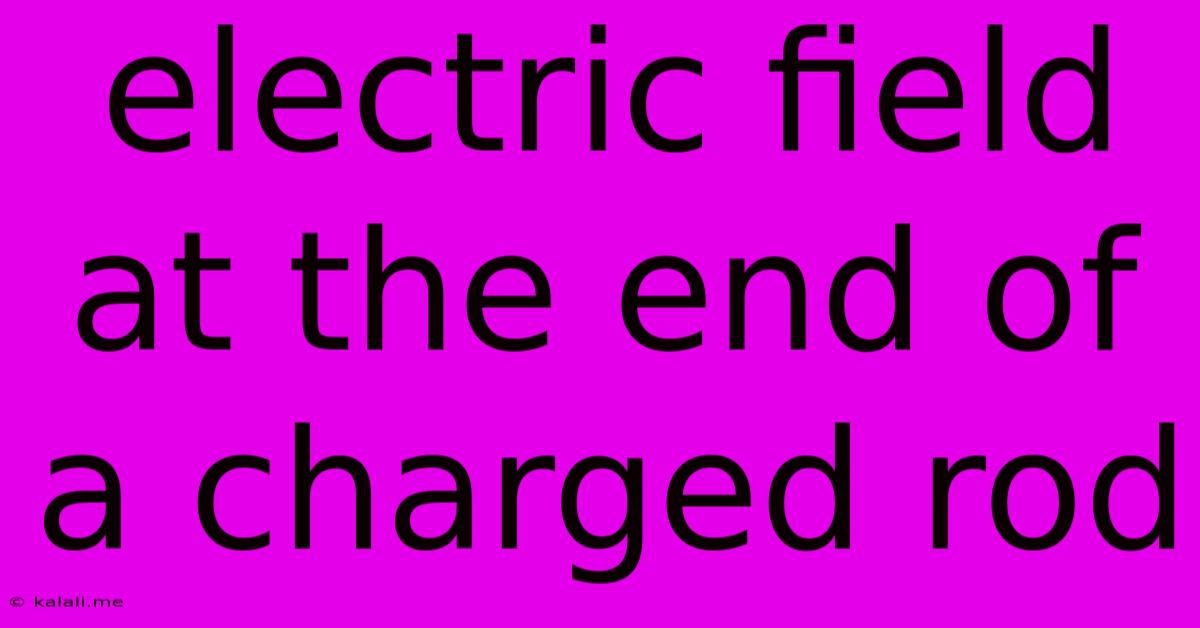Electric Field At The End Of A Charged Rod
Kalali
Jun 01, 2025 · 4 min read

Table of Contents
Calculating the Electric Field at the End of a Charged Rod
This article delves into the complexities of calculating the electric field at the end of a charged rod, a common problem in electrostatics. Understanding this calculation is crucial for various applications in physics and engineering, from designing electronic components to modeling atmospheric electricity. We'll break down the process step-by-step, offering a clear and concise explanation, suitable for both students and professionals. This detailed explanation will cover the necessary formulas, considerations for different charge distributions, and potential challenges in the calculation.
The electric field at the end of a charged rod is a classic problem in electrostatics that requires integration to solve. Unlike the electric field due to a point charge, which is easily calculated using Coulomb's law, the rod's extended nature necessitates a more sophisticated approach. The challenge lies in summing up the contributions of infinitesimally small charge elements along the rod's length.
Understanding the Setup
Imagine a thin, uniformly charged rod of length L carrying a total charge Q. We want to find the electric field at one end of this rod. This is a good example of how to handle continuous charge distributions, a key concept in electromagnetism. We'll assume the rod is along the x-axis, with one end at the origin (x=0) and the other end at x=L.
The Integral Approach
To solve this, we'll employ calculus. We'll break the rod into infinitesimally small segments, dq, each contributing a small electric field, dE, at the point of interest (the end of the rod). Coulomb's law provides the basis for calculating dE:
dE = k * dq / r²
where:
- k is Coulomb's constant (8.98755 × 10⁹ N⋅m²/C²)
- dq is the charge of an infinitesimal segment of the rod
- r is the distance from the segment dq to the point where we're calculating the field
Because the rod is uniformly charged, the linear charge density, λ, is constant:
λ = Q / L
Therefore, dq = λ * dx, where dx is the length of the infinitesimal segment. The distance r is simply x (the position of the segment along the rod). Substituting these into the equation for dE, we get:
dE = k * λ * dx / x²
This equation gives us the magnitude of the electric field due to a single infinitesimal segment. To find the total electric field, we need to integrate this expression over the entire length of the rod:
E = ∫₀ᴸ k * λ * dx / x²
This integral evaluates to:
E = k * λ * [ -1/x ]₀ᴸ = k * λ * (1/L - ∞)
Notice that the above equation results in infinity if applied directly to the end of the rod, meaning we have a singularity at the endpoint. This highlights a key difficulty in calculating the electric field directly at the end of a charged rod. The electric field becomes infinitely large.
Avoiding the Singularity: Approaching the End
The infinity arises because we're trying to evaluate the field precisely at the end of the rod, where the distance r goes to zero. To resolve this, we should instead calculate the electric field at a point very close to the end, but not exactly at the end. Let's say we're calculating the field at a distance ε from the end of the rod. The integral then becomes:
E = ∫₀ᴸ k * λ * dx / (x + ε)²
This integral is solvable and yields a finite result, dependent on ε. By letting ε approach zero, we can obtain an accurate approximation of the electric field very close to the end of the rod. The exact solution would depend on the integration limits and is best solved using appropriate mathematical software or by performing the integration with a Computer Algebra System (CAS).
Conclusion
Calculating the electric field at the end of a charged rod requires careful consideration of the integral approach and the handling of singularities. While a direct calculation at the very end yields infinity, calculating the field at a point infinitesimally close provides a realistic and physically meaningful approximation. This problem demonstrates the importance of understanding both the theoretical concepts of electrostatics and the practical applications of calculus in solving physics problems. Remember to utilize mathematical software for precise numerical solutions, especially when dealing with complex integrations.
Latest Posts
Latest Posts
-
Is It Safe To Turn Off Water To Water Heater
Jun 03, 2025
-
Why Did Mary And Joseph Go To Bethlehem
Jun 03, 2025
-
5 Amp Fuse Keeps Blowing Furnace
Jun 03, 2025
-
How To Get Rid Mold In The Bathroom
Jun 03, 2025
-
Charlie Sheen Banging 7 Gram Rocks
Jun 03, 2025
Related Post
Thank you for visiting our website which covers about Electric Field At The End Of A Charged Rod . We hope the information provided has been useful to you. Feel free to contact us if you have any questions or need further assistance. See you next time and don't miss to bookmark.